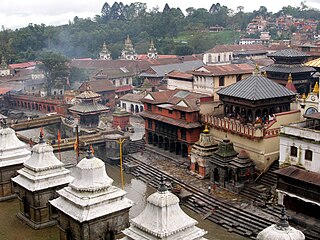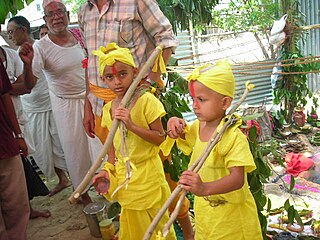
The history of Nepal is intertwined with the history of the broader Indian subcontinent and the surrounding regions, comprising the areas of South Asia and East Asia.

The Kingdom of Nepal, also known as the Kingdom of Gorkha or Gorkha Empire or Asal Hindusthan, was a Hindu kingdom on the Indian subcontinent, formed in 1768, by the unification of Nepal. Founded by King Prithvi Narayan Shah, a Gorkhali monarch of Rajput origin from medieval India, it existed for 240 years until the abolition of the Nepalese monarchy in 2008. During this period, Nepal was formally under the rule of the Shah dynasty, which exercised varying degrees of power during the kingdom's existence.

Maharajadhiraja Prithivi Narayan Shah was the last ruler of the Gorkha Kingdom and first monarch of Kingdom of Nepal in the Indian subcontinent. He claimed to be a Gorkhali monarch of Rajput origin from medieval India. Prithvi Narayan Shah is credited for starting the campaign for the unification of Nepal.

The Magar, also spelled as Mangar, and Mongar, are the third largest ethnolinguistic groups of Nepal representing 7.1% of Nepal's total population according to the Nepal census of 2011.
Gorkha Kingdom was a kingdom in the confederation of 24 Khas tribes states, known as Chaubisi rajya, located in the Indian subcontinent, present-day western Nepal. The Kingdom of Gorkha extended from the Marshyangdi River in the west to the Trishuli River in the east, which separated it from the kingdoms of Lamjung and Nepal respectively. The Gorkha Kingdom was established by Prince Dravya Shah, second son of King Yasho Brahma Shah of Lamjung Kingdom, on 1559 CE replacing the Khadka chiefs.

Hinduism is the main and largest religion of Nepal. The Constitution of Nepal has established a call for the protection of this age-old religion throughout the country.In 2007 the country declares itself that it is a secular country while some special privileges were also given to Hinduism. According to the 2011 census, the Hindu population in Nepal is estimated to be around 22,493,649 including native kirat Mundhum, Prakriti and Bon which have deep roots and strong connection with Sanatan Dharma and all together accounts for at least 85% of country's population. The national calendar of Nepal, Vikram Samvat, is a solar Hindu calendar essentially the same to that widespread in North India as a religious calendar, and is based on Hindu units of time.

The Shah dynasty, also known as the Shahs of Gorkha or the Royal House of Gorkha, was the ruling Chaubise Thakuri dynasty from the Indian subcontinent; and derived from the Gorkha Kingdom from 1559 to 1768 and later the unified Kingdom of Nepal from 1768 to 28 May 2008.

Before the Shah dynasty united Nepal, only Kathmandu was known as Nepal or Nepal Mandala. After conquering all the small kingdoms of Nepal in the mid-eighteenth century, King Prithvi Narayan Shah moved his capital to Kathmandu from Gorkha and named the newly created empire, Nepal.

Nuwakot District (Nepali: नुवाकोट जिल्ला
The Malla Dynasty was the ruling dynasty of Kathmandu Valley from c. 1201–1779 CE in the Indian subcontinent. They have claimed Kshatriya status for themselves. The term Malla mean "wrestler" in Sanskrit. The first of the Malla kings came to power in Kathmandu Valley around 1200 CE. The Malla period was a golden one that stretched over 600 years, though it was peppered with fighting over the valuable trade routes to Tibet.

Religion in Nepal encompasses a wide diversity of groups and beliefs; however, Nepal's major religion is Hinduism which accounts for 81.3% of the overall population as of 2011. According to a survey, Nepal is the most religious Hindu country throughout the world, with most of the important Hindu pilgrimage centers concentrated in this country. It is a multi-cultural, multi-ethnic, multi-lingual and multi-religious nation through democracy. Shiva is widely regarded as the guardian deity of Nepal. Nepal is home to the world-famous Pashupatinath Temple, a UNESCO World Heritage Site, where Hindus throughout the world come for pilgrimage purposes. According to Hindu mythology, the goddess Sita of the epic Ramayana was born in the Mithila Kingdom of King Janaka Raja. The national animal of Nepal is the cow, which is considered a sacred animal in Hinduism. Because of this, the slaughter of cows is illegal in Nepal.
Gurung Shamanism is one of the oldest religions in Nepal. It describes the traditional shamanistic religion of the Gurung people of Nepal.

Anil Gurung is a Nepali footballer who plays as a Striker for Brigade Boys Club in the Martyr's Memorial A-Division League.

Seto Machindranath, also known as Janabaha Dyo, Avalokiteśvara, Karunamaya, Guanyin is a deity worshiped by both Hindus and Buddhists in Kathmandu, Nepal. The temple of Seto Machindranath is located in Jana Bahal. Located at Keltole between Ason and Indra Chok in central Kathmandu, the temple is believed to have been established around the 10th century. Seto Machindranath is worshiped as an aspect of Avalokiteshvara.
Tamu Samaj is a society of Tamus, an ethnic group from Nepal. The Tamu societies are created around the world as a means to preserve Tamu's unique culture outside of Nepal. They organise cultural events, such as festivals of dance, music, and food. They also engage in humanitarian, social and educational activities. There are a number of Tamu Samajs around the world, including: Tamu Samaj Sydney, Tamu Samaj Victoria, Tamu Samaj UK, but some inherit different names such as "Gurung Tamu Society".
"Melancholy" is an environmentally-themed song sung by 365 Nepali artists. This song was intended to promote an environmental message by breaking the Guinness World Records for "Most Vocal Solos in a Song Recording", which it successfully did. It was written, music composed and directed by environmentalist Nipesh Dhaka. The song was recorded as a single on 19 May 2016. The recording sessions were inaugurated by Prime Minister Khadga Prasad Oli at 8 am and continued until 6 pm. The song was released on 2 September 2017 by President Bidya Devi Bhandari at Army Officer's Club, Kathmandu.
Swarup Singh Karki or Swaroop Singh Karki, was a Nepali politician, courtier, military commander and minister. He was popular for his singing prowess and court conspiracies. He was selected as Dewan in the reign of King Pratap Singh Shah and a significant politician in the regent rule of Queen Rajendra of Nepal. He was one of the most influential court politician in the rule of King Pratap Singh and Queen Rajendralaxmi others being his rival Bahadur Shah of Nepal and Vamsharaj Pande. Vamsharaj was his perceived career rival. His life and career ended when Prince Bahadur Shah was appointed as regent in 1785.

Tagadhari are members of a Nepalese Hindu group that is perceived as historically having a high socio-religious status in Nepalese society. Tagadhari are identified by a sacred thread (Janai) around the torso, which is used for ritualistic purposes in Hinduism. In Sanskrit the sacred thread is called yajñopavītam and in Nepali Janai. The cord is received after the Upanayana ceremony. Tagadharis were historically favoured by the government of Nepal and various religious and caste-based legal provisions were enacted on their behalf. The legal code of 1854, Muluki Ain, which was introduced by Chhetri Maharaja and Prime Minister of Nepal, Jang Bahadur Kunwar Ranaji made it impossible to legally enslave Tagadharis and decreed fewer punishments for them in comparison to Matawali and Dalits.
Tularam Pande was Nepalese military personnel, diplomat and politician in the Gorkha Kingdom. He was a diplomat who served King Prithvi Narayan Shah of Gorkha. Two of his diplomatic missions were with Dolakha and Kathmandu while the latter remained unsuccessful. He also served as the national military commanders in the forces of Prithvi Narayan Shah. He was the patron of the Gora Pande clan, a minor faction of the Gorkha-based aristocratic Pande family. Some of his patrilineal descendants became influential politicians such as Ranajit Pande and Dalabhanjan Pande in the Nepalese history through their marital ties with the Thapa dynasty. His matrilineal descendants became significantly influential; Queen Tripurasundari of Nepal went on to become Queen Mother of Nepal and Mathawar Singh Thapa - the Prime Minister of Nepal and Jang Bahadur Kunwar Ranaji - the latter period ruler of Kaski & Lamjung and Prime Minister of Nepal.
Rajputs of Nepal or anciently Rajputras are Rajput community of Nepal. As per the 2011 Nepal census, the population of Rajputs is reported at 41,972.